AI PDF summarizer tools cut down document analysis time by 70%. Many professionals spend countless hours reading long documents and reports. The statistics show they waste almost 50% of their time searching for information.
The best AI PDF summarizer options have evolved significantly by 2025. These AI summarizers extract essential ideas from large documents and present them clearly. Our team has tested many AI tools that summarize PDFs and help users quickly find relevant data.
AI summarizers prove especially valuable when you have students who must process large research materials. Our business suggests both free and premium AI PDF summarizer options in this piece. We have assessed all but one of these 15 tools to help you select the perfect solution that matches your needs.
1. Lindy
Image Source: Lindy
Lindy is a remarkable ai pdf summarizer that turns your documents into clear summaries with minimal setup. Our business uses Lindy because it turns long PDFs into easy-to-read information.
Lindy key features
Lindy has several impressive capabilities that make it an excellent ai to summarize pdf choice:
- Automatic PDF summarization – You get relevant summaries the moment you upload your document
- Custom instructions – You decide how Lindy presents your information
- Extensive integrations – Your workflow connects with over 3,000 apps
- Feedback learning – Your input helps Lindy create more accurate summaries
- Document chat – Get instant answers when you ask questions about your PDFs
Lindy works with many document types. You can use it with Google Docs, Word documents, and webpages alongside PDFs.
Lindy pros and cons
Pros:
- Works with thousands of tools to simplify your workflow
- Support available round the clock through Lindy Academy
- Your feedback trains the system to create personalized summaries
- Easy-to-use design works well for everyone
Cons:
- You might need to adjust some integrations manually
- Setting up complex workflows takes time
- Free plan’s credit limits could restrict heavy users
Lindy pricing
Lindy’s pricing plans suit different needs:
- Free Plan – Start with 400 monthly credits
- Starter Plan – Get 5,000+ credits at $49.99/month for small teams
- Business Plan – Access 30,000+ credits at $299.99/month for bigger organizations
Every plan includes SOC 2, HIPAA, and PIPEDA compliance features.
Lindy best use case
Lindy shines as an ai summary tool by doing more than basic summarization. Most free ai pdf summarizer tools create simple text summaries. Lindy takes those summaries and turns them into useful workflows. Our business found it perfect for teams that handle complex document processes.
The tool attends meetings, pulls important details from PDFs, spots action items, and handles tasks automatically across connected platforms. Professionals who need quick insights from research materials, reports, or lengthy documents while keeping their workflow smooth will find Lindy invaluable.
2. Quillbot
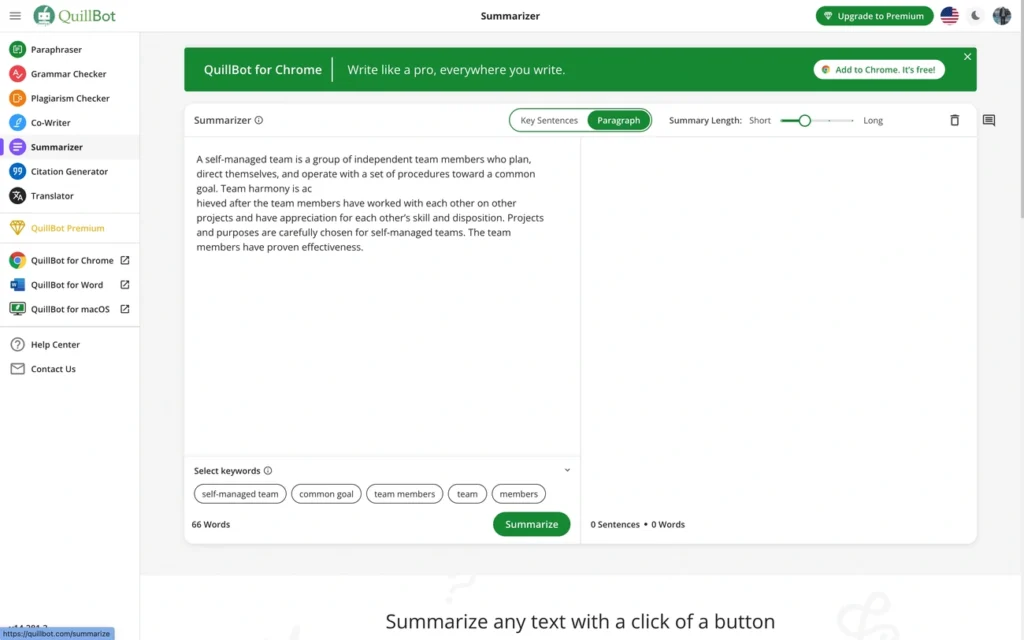
Image Source: Wondershare EdrawMax
QuillBot is an easy-to-use ai pdf summarizer with over 50 million users. Our business discovered its excellence at converting complex documents into easily digestible formats for busy professionals.
Quillbot key features
QuillBot’s powerful capabilities make it stand out as an ai to summarize pdf tool:
- Dual summarization formats – Choose between paragraph-style or key sentences format
- Adjustable summary length – Control output length with a simple slider
- Document statistics – View word count reduction, sentence count, and summary percentage
- Export options – Copy/paste or export as Word document
- Multi-platform extensions – Available for Chrome, macOS, and Microsoft Word
- Additional writing tools – Has paraphraser, grammar checker, and plagiarism detector
QuillBot supports multiple languages through its built-in translator for 45+ languages, making it available to international users.
Quillbot pros and cons
Pros:
- Processes up to 1,200 words with the free ai pdf summarizer plan
- Easy-to-use interface needs minimal learning
- Versatile extensions increase efficiency across platforms
- Paraphrasing tool helps rewrite content in different styles
Cons:
- Audio or video files cannot be summarized
- Free plan has limited features and word count restrictions
- Some reviews show summaries might contain unnecessary content
- Technical materials don’t work very well
Quillbot pricing
QuillBot’s flexible pricing suits different needs:
- Free Plan – Summarize up to 1,200 words, simple features
- Premium Monthly – $19.95/month
- Premium Semi-Annual – $13.33/month ($79.95 billed every 6 months)
- Premium Annual – $8.33/month ($99.95 billed annually)
Premium plan users can summarize up to 6,000 words and get features like custom summary instructions and faster processing.
Quillbot best use case
QuillBot works best at simplifying complex text. Time-pressed students, overwhelmed researchers, and busy professionals benefit from its quick insights from articles and reports.
The tool excels at converting dense, technical documents into understandable content. Our business tests confirm its ability to paraphrase and simplify language while keeping the core meaning intact. This makes it perfect for people who find complex material challenging or need to quickly understand key points from extensive reading.
3. ChatGPT

Image Source: PDFgear
ChatGPT now lets users summarize PDFs directly through its latest models, unlike other specialized tools. We tested how this popular AI assistant handles document analysis tasks.
ChatGPT key features
ChatGPT offers these powerful capabilities as an ai pdf summarizer:
- Direct PDF uploads – You can upload PDFs right in the chat interface (GPT-4 and above)
- Customizable summaries – You get to choose summary lengths and formats
- Section-specific analysis – The tool analyzes complete documents or selected pages
- Multiple summarization styles – You can create executive overviews, detailed outlines, or bullet points
- Follow-up questions – The system lets you dig deeper into specific details after summarization
Users can upload files—including PDFs—directly in the chat for processing and summarization since GPT-4’s release.
ChatGPT pros and cons
Pros:
- Quick document processing saves hours of reading time
- Summaries stay consistent across different documents
- Less human bias in content interpretation
- Works with various document formats beyond PDFs
Cons:
- The free version lets you upload only 3 files per day
- Token limits stop you from processing large documents
- Complex layouts, tables, and charts can be challenging
- Scanned PDFs need OCR conversion first
ChatGPT pricing
- Free Plan – You get basic access with 3 file uploads daily
- ChatGPT Plus – $20 monthly brings priority access to GPT-4 and extra features
- ChatGPT Team – $30 per user monthly with expanded features
- Enterprise – Custom pricing includes advanced security
Developers building custom solutions should note that API usage comes with additional token-based costs.
ChatGPT best use case
ChatGPT shines as an ai for summarizing pdf documents that need analytical thinking. The tool works best with research papers, technical documentation, and business reports that require context understanding.
The system lets you interact with documents beyond simple summaries. You can ask specific questions about content sections or request different formats of the same information.
4. Notta
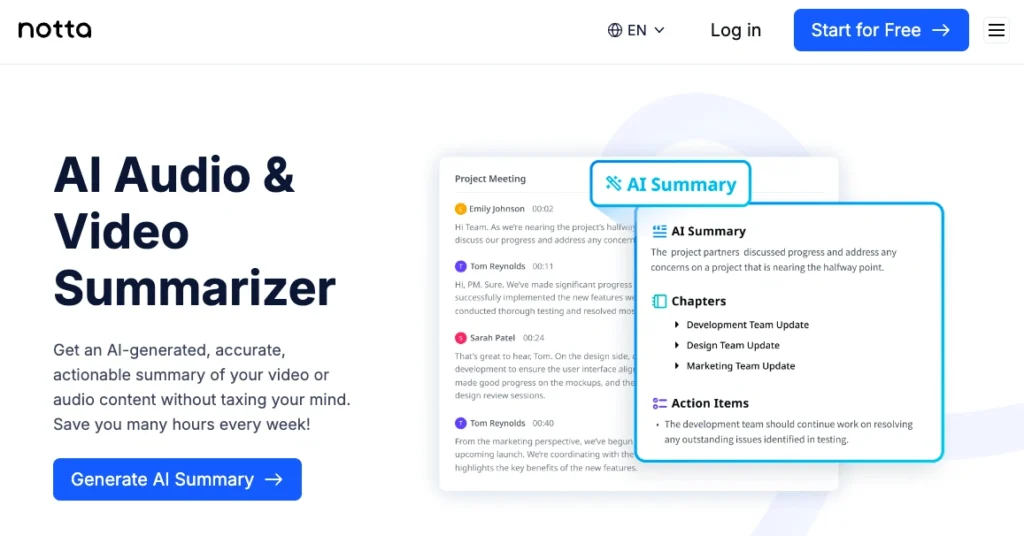
Image Source: Notta
Notta stands out as an ai pdf summarizer with remarkable audio-to-text capabilities that achieve 98.86% accuracy. Our team found this tool works best for professionals who need to extract insights from recordings and documents.
Notta key features
Notta’s powerful capabilities make it an outstanding ai summary tool:
- Real-time transcription – Convert live speech to text in 58 languages
- Bilingual transcription – Support for 11 language pairs for global teams
- AI-powered summaries – Extract key points, chapters, and action items automatically
- Chrome extension – Transcribe audio from any webpage and summarize later
- Meeting integration – Works with Zoom, Google Meet, Microsoft Teams, and Webex
- Speaker identification – Tags different speakers automatically for better clarity
Notta can create mindmaps of your discussions, which helps teams visualize complex topics effectively.
Notta pros and cons
Pros:
- Handles content through direct uploads or URLs from YouTube, Google Drive, or Dropbox
- AI templates adapt to different meeting types
- Multiple export formats available: TXT, DOCX, PDF, and SRT
- Built-in scheduling eliminates email back-and-forth
Cons:
- Free plan restricts conversations to 3 minutes
- Text-only PDFs need conversion before summarization
- Web app needs stable internet connection
- Speaker voice differentiation issues reported by free plan users
Notta pricing
- Free Plan – 120 transcription minutes monthly, 3-minute limit per conversation
- Pro Plan – $8.25/month with annual billing or $13.49 monthly, 1,800 minutes/month
- Business Plan – $16.67 monthly per user with annual billing or $27.99 per user monthly
- Enterprise Plan – Custom pricing meets advanced security requirements
Notta best use case
Notta excels as an ai to summarize pdf solution for teams handling multilingual meetings. Beyond its transcription capabilities, Notta’s PDF summarization features serve education, consulting, and media professionals who alternate between document reviews and live discussions.
5. Scribbr
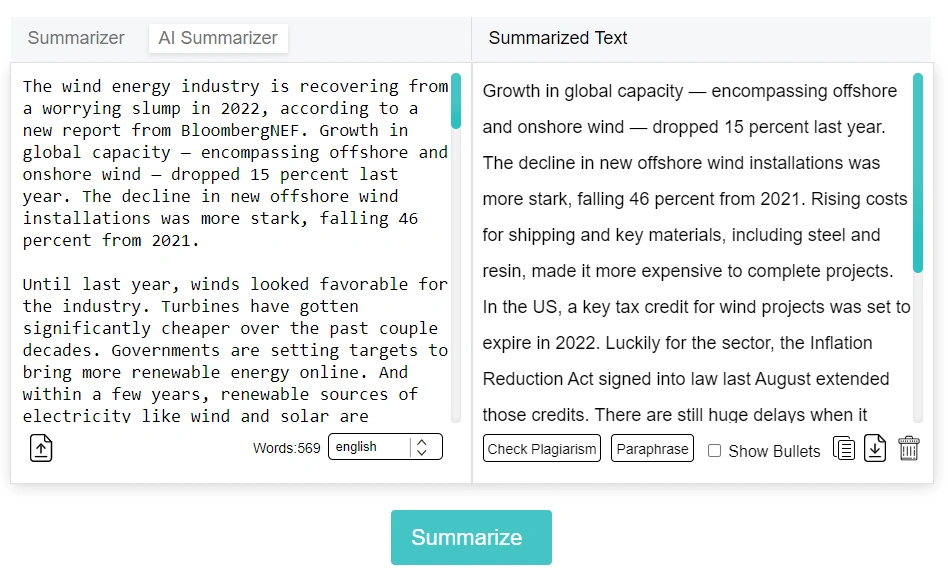
Image Source: Scribbr
Scribbr gives scholars and researchers a specialized ai pdf summarizer built for academic content. We recommend this tool to students who want to learn about scholarly articles and research papers quickly.
Scribbr key features
The academic capabilities of Scribbr are impressive:
- Dual summary formats – You can create text or bullet-point summaries that match your needs
- Customizable focus – Your chosen keywords help direct the summary’s emphasis
- Downloadable results – The summaries save as TXT files you can reference later
- Re-summarize option – A simple slider lets you adjust summary length
- Text highlighting – The tool shows which original text appears in the summary
- Plagiarism checking – The feature helps maintain academic integrity
QuillBot powers Scribbr’s technology and delivers clear, concise, and fluent summaries.
Scribbr pros and cons
Pros:
- The tool costs nothing and comes with no hidden fees
- You can start using it without signing up
- The plagiarism checking feature adds extra value
- The user-friendly interface works well on desktop and mobile devices
- You get both paragraph and bullet-point style summaries
Cons:
- Text input stops at 600 words
- The tool only works with English content
- URL summarization isn’t available
- Premium tools give you more customization options
Scribbr pricing
The summarizer comes completely free without a premium version right now. Every summarization feature remains accessible without any payment or subscription needed.
Scribbr best use case
Scribbr shines as a free ai pdf summarizer in academic settings. The tool excels when students need to condense complex scholarly articles, research papers, and academic texts into digestible summaries.
Students with tight deadlines love Scribbr’s straightforward approach and focus on academic integrity. To name just one example, researchers can pull key points from academic literature without plagiarism concerns.
Our testing shows Scribbr works best with shorter academic texts rather than long reports because of its 600-word limit.
6. Jasper
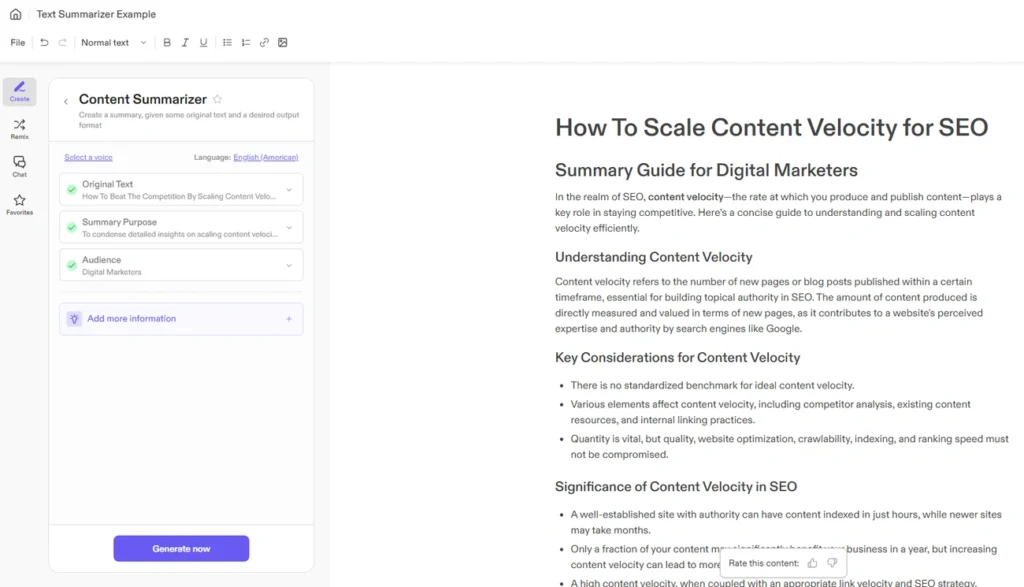
Image Source: Jasper
Jasper is a marketing-first ai pdf summarizer that blends document analysis with brand-specific content generation. We looked at how over 100,000 companies use this platform to process documents and create on-brand content. Users gave it a solid 4.8/5 star rating.
Jasper key features
Jasper sets itself apart with these capabilities:
- Text summarization – You can process up to 5,000 characters into clear summaries
- Multilingual support – The tool creates summaries in over 25 languages
- Brand voice matching – Your style guides help create customized, on-brand summaries
- Chrome extension – You can summarize content right from your browser
- AI-powered analysis – The system pulls key insights with custom formality levels
The sort of thing I love about Jasper is how it turns summaries into different formats—like social media posts or email content—while keeping the important details intact.
Jasper pros and cons
Pros:
- The summaries make sense and stay relevant to the context
- You can match your unique style and tone priorities
- The tool helps with many writing tasks beyond summarization
- It works well with marketing tools of all sizes
Cons:
- You’ll pay more compared to other options
- Some outputs can feel too generic
- Complex technical or creative content can be challenging
- All but one of these versions can process PDFs directly
Jasper pricing
- Pro Plan – $59/month (billed yearly) or $69/month (billed monthly)
- Business Plan – Custom pricing includes extra security and support
- Free Trial – You get 7 days to try Pro features risk-free
Non-profit organizations can get a 20% discount.
Jasper best use case
Marketing teams that need on-brand document summaries will find great value in Jasper. Unlike simple ai summary tools, this platform creates summaries that match your company’s voice and blend with your marketing workflow.
The tool reshapes lengthy reports into content for emails, social media, and other marketing channels—while keeping your brand consistent. Teams working in multiple languages will appreciate its language capabilities.
7. Scholarcy
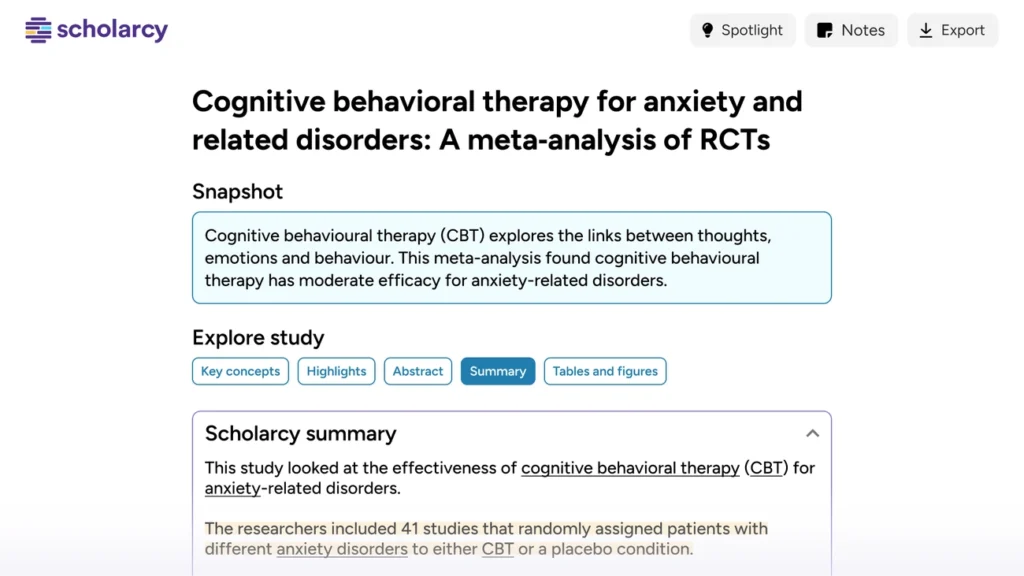
Image Source: Scholarcy
Scholarcy helps academic researchers by turning complex papers into easy-to-read flashcards as a specialized ai pdf summarizer. The tool processes scholarly literature accurately, which our business team discovered through testing.
Scholarcy key features
Scholarcy delivers these academic-focused capabilities:
- Flashcard summaries – Papers become structured, interactive flashcards quickly
- Extractive AI – Smart AI models detect specific sequences without hallucinations
- Reference extraction – The system finds related papers and shows comparisons automatically
- Table data export – Tables convert smoothly into Excel-friendly formats
- Multi-language support – The tool reads papers across languages
- Reference manager integration – Connects with Mendeley, Zotero, and EndNote
Scholarcy pros and cons
Pros:
- Makes one-click bibliographies in BibTeX format
- Comes with free Chrome and Edge extensions
- Works with multiple file formats (PDF, DOCX, HTML, ePub)
- Users rate it 4.2 on Chrome Web Store
Cons:
- Free version stops at 3 summaries daily
- The interface needs polish according to some users
- Broad approach might skip details in specialized texts
- Document management tools need expansion
Scholarcy pricing
- Free Plan – 3 article summaries each day
- Monthly Plan – $9.99/month unlocks unlimited summaries and better features
- Annual Plan – Save 25% versus monthly payments
- Academic Institution License – Starts at $8,000 yearly for full access
Scholarcy best use case
Research-heavy environments get the most value from Scholarcy. This ai to summarize pdf tool shines with academic papers and cuts reading time significantly. Graduate students love how it pulls out key methodology, results, and references from complex scholarly work.
8. ClickUp
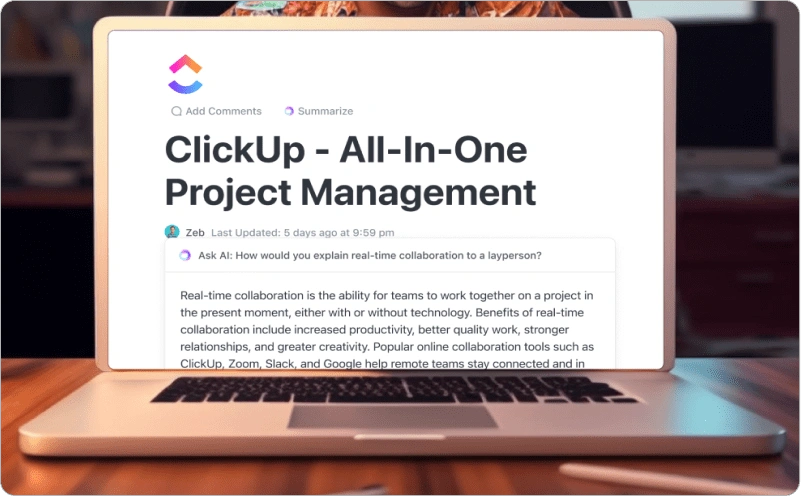
Image Source: ClickUp
ClickUp merges project management with ai pdf summarizer capabilities through its Brain feature. The company assessed how this comprehensive platform handles document analysis among task management tools.
ClickUp key features
ClickUp Brain provides these summarization capabilities:
- Document summarization – The system can summarize complete docs or selected text portions
- Task thread summaries – Users get quick overviews of project discussions
- Multiple AI models – Users can access GPT-4o, Claude 3.7, and other LLMs
- Translation – The platform generates summaries in different languages
- Action item extraction – The system identifies next steps from documents automatically
The platform merges with 50+ platforms including Google Drive and Microsoft Teams.
ClickUp pros and cons
Pros:
- The system creates summaries within your workflow
- Mid-market companies save around $94,000 each year
- The free plan includes unlimited tasks and users
Cons:
- The user-friendly interface requires time to master
- The core team features need Enterprise plan
- PDF summarization needs copy-pasting
ClickUp pricing
- Free Forever – Simple features with unlimited users
- Unlimited – $7-$10/user monthly with storage and automation
- Business – $12-$19/user monthly with advanced features
- Enterprise – Custom pricing with improved security
- ClickUp Brain – $7/user monthly add-on includes AI features
ClickUp best use case
The platform works best as an ai summary tool for teams that need document analysis within project workflows. The system outperforms standalone summarizers when teams need summaries linked to tasks, project updates, and team collaboration.
9. Writesonic

Image Source: Writesonic
Writesonic stands out as a versatile ai pdf summarizer that runs on OpenAI’s LLM with specialized training for marketing professionals. We found that this tool goes beyond simple summarization and provides robust content generation capabilities.
Writesonic key features
- Concise text summaries – You can create clear, compelling summaries with a single click
- Multilingual support – The tool generates summaries in 25+ languages including French, Spanish, and Japanese
- Marketing-specific training – The system excels at creating hooks and promotional content
- Article generation – You can combine multiple blog posts into one cohesive article
- Channel-specific formats – The platform lets you tailor summaries for different distribution channels
Writesonic pros and cons
Pros:
- A clean interface that makes writing easier
- Quick drafts that speed up your writing process
- Powerful SEO optimization features that boost content ranking
- The price point beats many similar tools in the market
Cons:
- Your content quality varies based on credit usage
- The output sometimes contains repetitive phrases
- Some factual errors might slip through and need editing
- The user-friendly design still needs time to master
Writesonic pricing
- Lite – $49/month with 15 articles and 2 writing styles
- Standard – $99/month with 30 articles and 5 writing styles
- Professional – $249/month with 100 articles and 2 users
- Advanced – $499/month with 200 articles and 5 users
Writesonic best use case
Marketing teams that need quick summaries across multiple channels will find Writesonic most valuable. The process is straightforward – upload your PDF or paste text, pick your language and quality settings, and get your summary. Teams can turn lengthy reports into social media content, email campaigns, or blog posts while keeping their brand’s voice consistent.
10. PDF.ai
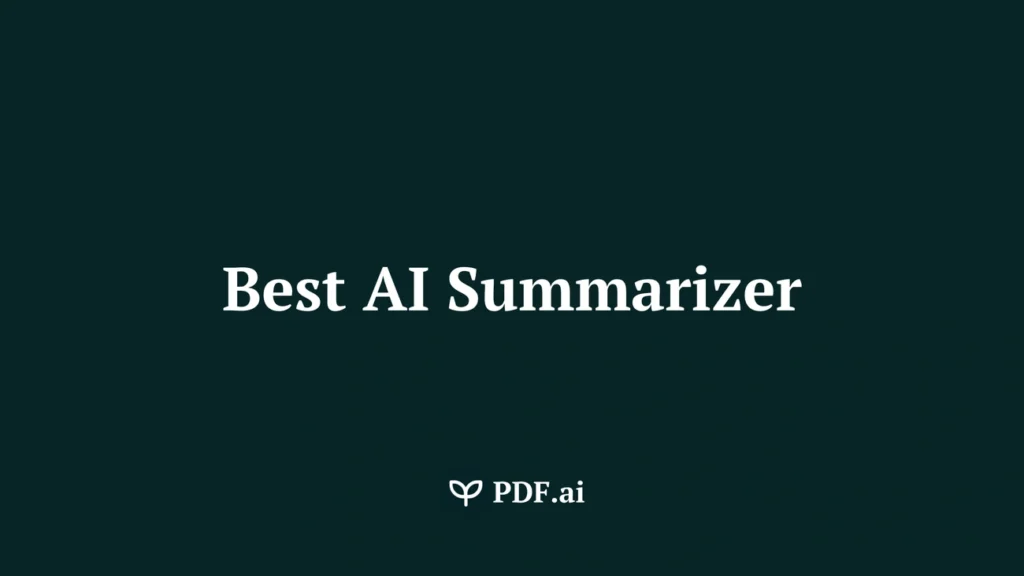
Image Source: PDF.ai
PDF.ai works as an interactive ai pdf summarizer that lets you chat with your documents naturally. The tool revolutionizes static PDFs into conversational resources that help retrieve information quickly.
PDF.ai key features
- Document chat – Get instant, source-referenced answers when you ask questions about content
- Built-in OCR – Handle scanned documents and image-based PDFs seamlessly
- Specialized AI agents – Set up custom agents that work with legal, finance, healthcare, and education documents
- Chrome extension – Use features right from your browser
- Team collaboration – Analyze documents together with your colleagues
- Source highlighting – Each response links back to original document references
PDF.ai pros and cons
Pros:
- Answers link to sources that make verification easy
- Teams worldwide benefit from multiple language support
- Complex documents become easier to process
- Notion and Slack integration enhances workflow
Cons:
- Free plan gives you 1 PDF upload and 100 questions monthly
- Updated document versions need manual uploads
- Message limits could restrict teams with heavy usage
- You can only work with uploaded PDF content
PDF.ai pricing
- Hobby – Free forever with 1 PDF upload, 100 questions/month
- Pro – $17/month with 100 uploads, 1,000 questions/month
- Ultimate – $27/user/month for unlimited uploads/questions
- Enterprise – $37/user/month with 100MB file support
PDF.ai best use case
PDF.ai shines as an ai to summarize pdf when teams need interactive document analysis. Teams can extract specific information through natural conversations instead of reading entire documents.
11. SMMRY

Image Source: smmry.com
SMMRY is a minimalist ai pdf summarizer that makes text condensation quick and straightforward. We tested this established tool that puts simplicity first.
SMMRY key features
SMMRY provides everything you need without extra complexity:
- You can adjust summary length from brief to detailed
- Choose between bullet points or narrative formats
- Set topic-specific focus preferences
- Customize industry terminology
- Work with over 20 languages
- Process PDFs, Word documents, and web pages
The tool protects your privacy with bank-level encryption (AES-256) and removes all uploads from servers after processing.
SMMRY pros and cons
Pros:
- Lightning-fast summarization with response times under 50ms
- Start using it without signing up
- Handle PDFs, text inputs, and URLs
- Choose your preferred sentence output
Cons:
- Summaries can feel generic or too compressed
- The tool doesn’t deal very well with complex or technical content
- The interface looks dated compared to newer tools
- Summaries stop at 40 sentences
SMMRY pricing
- Free Plan – Simple access with text length limits
- Essential Plan – $7/month lets you create 20 summaries daily
- Pro Plan – $13/month unlocks unlimited summaries
SMMRY best use case
We recommend SMMRY for its speed and simplicity. The tool shines at giving quick overviews of shorter articles and web content when you need instant understanding without deep analysis. SMMRY suits users who want efficiency more than advanced features.
12. Resoomer
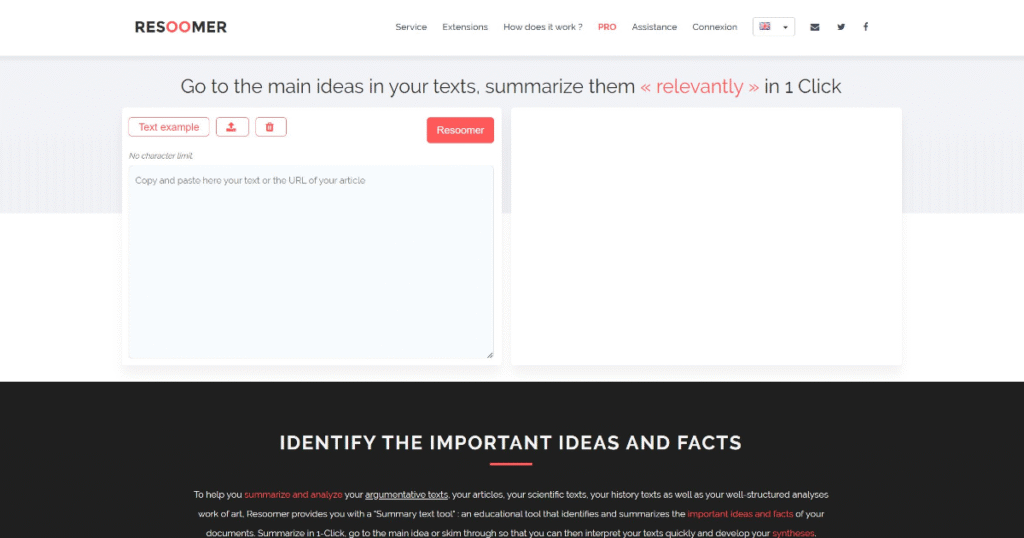
Image Source: Futurepedia
Resoomer functions as a simple ai pdf summarizer with multilingual capabilities across 66 languages. Our team tested this online tool that doesn’t require registration for simple use.
Resoomer key features
The tool provides several summarization approaches that match different needs:
- Multiple format support – Users can process PDF, EPUB, DOCX, ODT, and TXT files through drag-and-drop
- Language detection – The system identifies content language automatically without manual settings
- Four summary modes – Users can select from AI-assisted, automatic, manual, or optimized summaries
- Text analysis – The tool emphasizes key points for targeted reading experiences
- Audio playback – Users can listen to summaries in multiple languages
The platform also enables document library creation with encrypted storage to ensure confidentiality.
Resoomer pros and cons
Pros:
- Handles up to 15,000 characters per summary
- Combines smoothly with other tools for rewriting and translation
- The interface remains available to non-technical users
- Basic functions work without registration
Cons:
- The tool doesn’t deal very well with lengthy or complex documents
- Technical materials often lose nuances and context
- Registration comes without a trial option
- Summaries lack formatting options
Resoomer pricing
- Free Plan – Simple summarizer processes 15,000 characters
- PRO Plan – €9.90/month without commitment, includes YouTube video summarization
Resoomer best use case
We recommend Resoomer for educational settings. Students use it to summarize Wikipedia pages, and researchers benefit from quick document processing. Teachers can identify key concepts within seconds to prepare lessons.
13. SummarizeBot
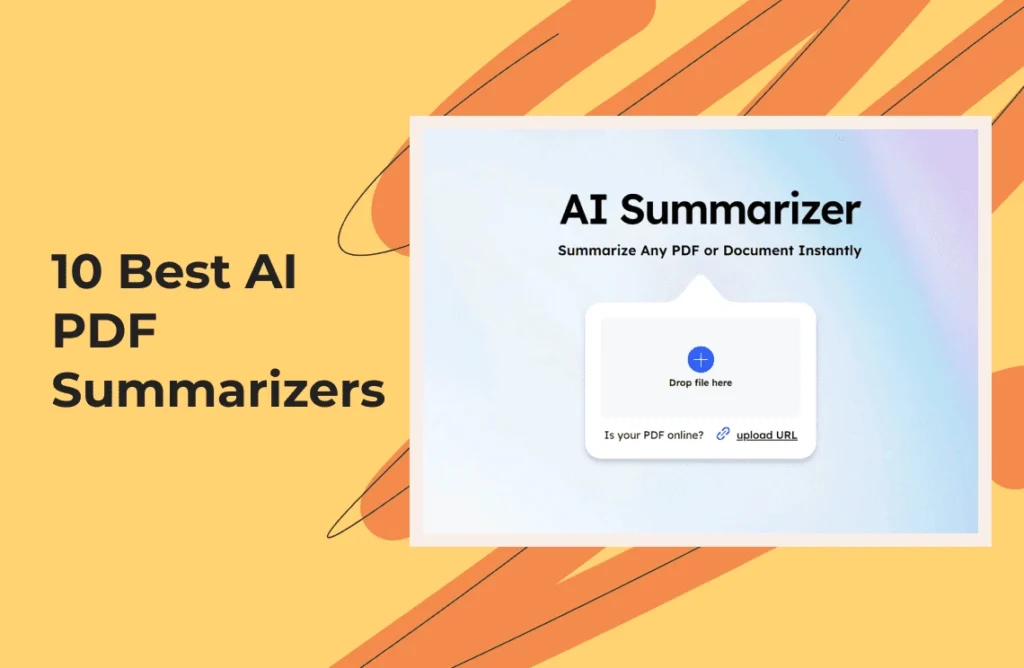
Image Source: PDF Agile
SummarizeBot utilizes ai pdf summarizer technology and blockchain to process text, audio, images, and documents of all types. Our business tested this versatile tool’s ability to handle multiple formats.
SummarizeBot key features
SummarizeBot’s multi-format functionality includes:
- Extract key information from PDFs, MP3s, DOCs, TXTs, JPGs
- Generate summaries with adjustable length options
- Extract important keywords and key fragments
- Support for multiple languages including English, Chinese, Japanese
- Audio summarization capabilities (beta feature)
- Share and save results for free
SummarizeBot pros and cons
Pros:
- Handles files beyond text documents
- Creates mind-maps and identifies key concepts
- Pulls relevant information from news articles
- Processes technical documents well
Cons:
- Desktop and mobile versions need a more easy-to-use interface
- Free plan limits file size to 3MB
- Summaries lack sufficient detail
- API plan starts at a steep $179/month
SummarizeBot pricing
- Free Trial – 14 days with 5,000 requests, 5 API calls/minute
- Standard – $179/month with 120,000 requests, 20 API calls/minute
- Custom – Pay-as-you-go with tailored features
SummarizeBot best use case
SummarizeBot works best for technical document analysis. The platform shines when you need to process multiple content formats in one place.
14. TLDR This
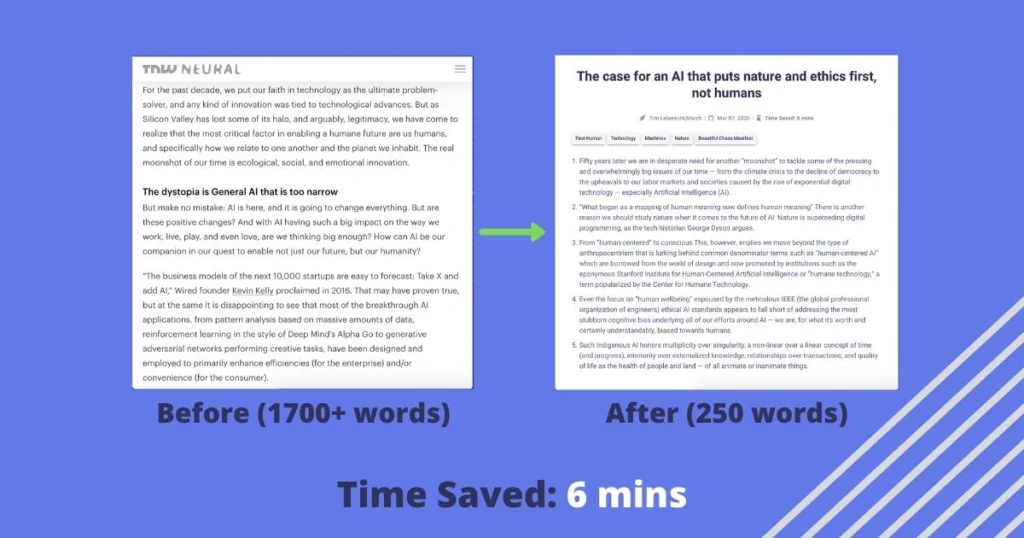
Image Source: www.tldrthis.com
TLDR This provides a web-based ai pdf summarizer with Chrome and Firefox browser extensions. Our team tested this tool and found it generates concise summaries without much effort.
TLDR This key features
The tool comes with several practical features:
- Two summary types – Users can choose between key sentences or AI-powered summaries
- Adjustable detail level – Options include short/concise or detailed/section-wise summaries
- Keyword highlighting – The system displays important keywords from summarized content
- Metadata extraction – The tool extracts author name, date, title, and reading time from articles
- Distraction-free reading – A clean reading experience without ads and popups
TLDR This pros and cons
Pros:
- Easy-to-use web interface with intuitive design
- Browser extensions boost daily efficiency
- Quick metadata extraction from articles
- Reading time reduces substantially
Cons:
- You need internet access to create summaries
- The free version limits AI summaries to 10
- Some summaries lack proper clarity
- No option to buy lifetime access
TLDR This pricing
- Free Plan – Users get unlimited basic summaries plus 10 AI summaries
- Starter Plan – $4.00/month includes 100 AI summaries monthly
- Professional Plan – $8.25/month provides 500 AI summaries monthly
- Business Plan – $16.60/month offers unlimited AI summaries
TLDR This best use case
Our team recommends TLDR This as an ai summary tool that helps readers quickly understand essential information from long articles. The name “Too Long; Didn’t Read” reflects its core purpose – creating condensed content for busy readers. Students find it helpful to create study materials, especially during exam preparation. However, readers who need detailed summaries covering all key points might want to look elsewhere.
15. Mindgrasp
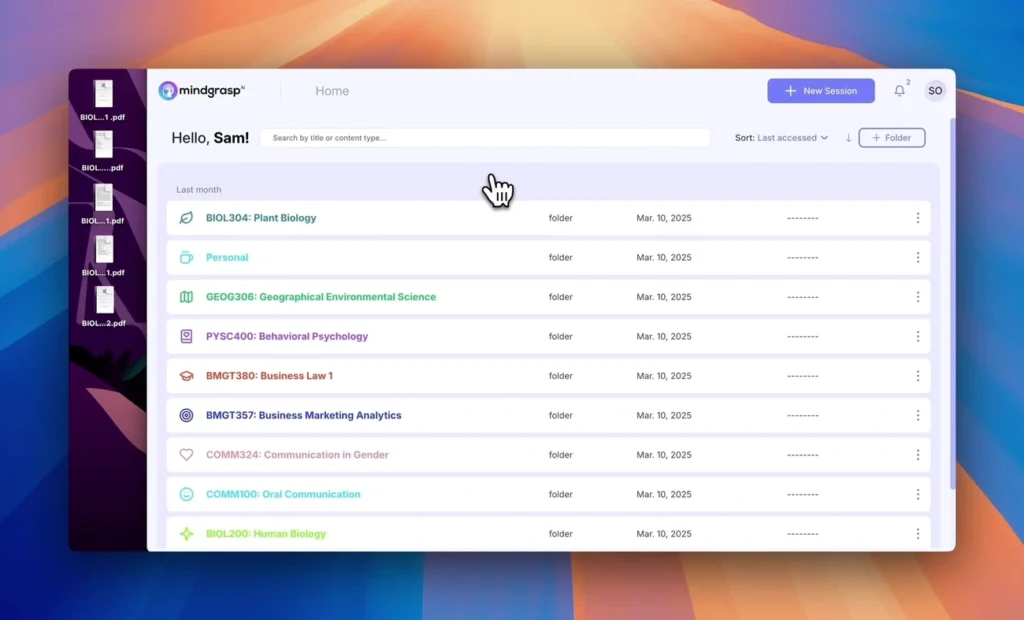
Image Source: Mindgrasp
Mindgrasp is an ai pdf summarizer built for educational settings. We took a close look at this AI learning assistant trusted by over 20,000 users globally.
Mindgrasp key features
Mindgrasp offers these powerful learning tools:
- Automated Content Summarization – Creates quick summaries from PDFs, videos, and documents
- Interactive Q&A – Responds instantly to questions about your uploaded content
- Quiz and Flashcard Generation – Makes study materials automatically from your documents
- Multi-Language Support – Works with more than 30 languages to help users worldwide
- Chrome Extension – Merges with Canvas, Blackboard, and Panapto
Mindgrasp pros and cons
Pros:
- Saves time with quick summarization
- Accessible interface
- Supports over 30 languages
- Works well for students, educators, and professionals
Cons:
- Free trial doesn’t offer all features
- Monthly costs might be high for casual users
- Complex content can lead to some inaccuracies
- Doesn’t deal very well with diagrams and graphs
Mindgrasp pricing
- Basic – $5.99/month ($71.88/year) with unlimited notes, summaries, and flashcards
- Scholar – $8.99/month ($107.88/year) adds Math Expert and Chrome Extension
- Premium – $10.99/month ($131.88/year) has multiple file uploads and image analysis
Every plan comes with a 4-day free trial.
Mindgrasp best use case
The sort of thing we love about Mindgrasp is how well it serves students and researchers. It turns lectures and readings into study materials effectively, while other tools just create simple summaries.
Comparison Table
| Tool | Key Features | Starting Price | Best Use Case | Notable Pros | Notable Cons |
|---|---|---|---|---|---|
| Lindy | – Automatic PDF summarization – Custom instructions – 3,000+ app integrations | Free (400 credits/month) | Teams managing complex document processes | – Support available 24/7 – Knowledge base training | – Manual integration adjustments needed – Complex setup process |
| Quillbot | – Two summary formats – Adjustable summary length – 45+ languages | Free (1,200 words) | Students and researchers who need simpler content | – Accessible interface – Multiple platform extensions | – No audio/video processing – Limited free features |
| ChatGPT | – Direct PDF uploads – Custom summaries – Follow-up questions | Free (3 files daily) | Research papers and technical documentation | – Swift processing – Interactive Q&A | – Small upload capacity – Token limits |
| Notta | – Live transcription – 58 languages – Meeting integration | Free (120 mins/month) | Multilingual teams managing meetings | – Multiple export options – Custom AI templates | – Limited free plan – Needs internet connection |
| Scribbr | – Two summary formats – Plagiarism checking – Text highlighting | Completely free | Academic settings | – No signup needed – Plagiarism check included | – 600-word limit – English only |
| Jasper | – 5,000 character processing – 25+ languages – Brand voice matching | $59/month | Marketing teams needing brand-aligned summaries | – Brand voice adaptation – Marketing tool integration | – Higher price point – Generic outputs |
| Scholarcy | – Flashcard summaries – Reference extraction – Table data export | Free (3 summaries/day) | Research-heavy environments | – One-click bibliographies – Multiple file formats | – Few free summaries – Interface issues |
| ClickUp | – Document summarization – Task thread summaries – Multiple AI models | Free (simple features) | Teams needing workflow integration | – Workflow integration – Unlimited free users | – Complex interface – Few PDF features |
| Writesonic | – Multiple language support – Marketing-focused training – Channel-specific formats | $49/month | Marketing teams creating content across channels | – Clean interface – SEO optimization | – Quality varies with credits – Repetitive output |
| PDF.ai | – Document chat – Built-in OCR – Source highlighting | Free (1 PDF, 100 questions) | Interactive document analysis | – Source-linked answers – Third-party integrations | – Limited free plan – Manual re-uploads |
| SMMRY | – Adjustable length – Multiple formats – 20+ languages | Free (simple access) | Quick article overviews | – Fast processing – No signup needed | – Generic output – Outdated interface |
| Resoomer | – 66 languages – Multiple file formats – Audio playback | Free (15,000 chars) | Educational settings | – Accessible interface – No signup needed | – Length limitations – No formatting |
| SummarizeBot | – Multi-format support – Keyword extraction – Mind-mapping | Free trial (14 days) | Technical document analysis | – Various file formats – Technical handling | – Poor interface – 3MB file limit |
| TLDR This | – Two summary types – Keyword highlighting – Metadata extraction | Free (10 AI summaries) | Quick article understanding | – Simple design – Browser extensions | – Needs internet – Limited free version |
| Mindgrasp | – Interactive Q&A – Quiz generation – 30+ languages | $5.99/month | Students and researchers | – Easy to use – Many languages supported | – Short free trial – Diagram issues |
Conclusion
These 15 AI PDF summarizers provide powerful solutions that fit different needs and budgets. The right tool depends on your specific requirements—whether you need academic paper analysis, marketing content creation, or simple document summaries. Our team’s testing showed that tools like Lindy excel at workflow integration, while Scholarcy proves valuable in research environments.
Free options like Scribbr or PDF.ai’s basic plans let you test the waters before upgrading to premium services. Language support, integration capabilities, and summary formats should shape your decision. The best tools help you extract vital insights without reading entire documents.
Our team suggests experimenting with multiple options because each tool brings unique advantages to different document types. Students, researchers, and business professionals can process information faster and make smarter decisions with these AI summarizers. The best AI PDF summarizers save time, but what about your business’s online presence? Mehnav doesn’t just build websites—we create beautiful, fast, and secure platforms that rank on Google AI and ChatGPT search. Our SEO ensures your brand visibility effectively. Ready to expand beyond PDFs and grow smarter? Visit mehnav.com.
Today’s information-heavy world demands smarter work with AI tools that give you a competitive edge. These summarizers turn hours of reading into minutes of focused understanding—exactly what busy professionals need to succeed.
Key Takeaways
These insights will help you choose the right AI PDF summarizer and maximize your document processing efficiency in 2025.
• AI PDF summarizers save up to 70% of document analysis time, transforming hours of reading into minutes of focused understanding for busy professionals.
• Free options like Scribbr and ChatGPT provide solid starting points, while premium tools like Lindy ($49.99/month) offer advanced workflow integration for teams.
• Choose tools based on your specific needs: Scholarcy excels for academic research, Jasper for marketing teams, and PDF.ai for interactive document analysis.
• Most tools support multiple languages and formats, with options like Notta handling 58 languages and SummarizeBot processing various file types beyond PDFs.
• Test multiple tools before committing since each offers unique advantages—some excel at technical documents while others shine with creative content or workflow integration.
The key is matching your document processing needs with the right tool’s strengths. Whether you’re a student analyzing research papers, a marketer creating content summaries, or a business professional managing reports, there’s an AI summarizer designed for your specific workflow and budget.
FAQs
Q1. What are the top AI PDF summarizers in 2025? Some of the best AI PDF summarizers in 2025 include Lindy, Quillbot, ChatGPT, Notta, and Scribbr. These tools offer features like automatic summarization, multilingual support, and integration with other productivity apps.
Q2. Are there any free AI PDF summarizer options available? Yes, several AI PDF summarizers offer free plans or trials. Scribbr is completely free, while tools like ChatGPT, SMMRY, and TLDR This provide limited free access. However, most advanced features typically require a paid subscription.
Q3. How do AI PDF summarizers save time for professionals? AI PDF summarizers can reduce document analysis time by up to 70%. They quickly extract key ideas from lengthy documents, allowing professionals to grasp essential information without reading entire reports, saving hours of work.
Q4. Can AI summarizers handle multiple languages? Many AI summarizers support multiple languages. For example, Notta works with 58 languages, Quillbot supports over 45 languages, and Mindgrasp functions across 30+ languages, making them suitable for global teams and international research.
Q5. What should I consider when choosing an AI PDF summarizer? When selecting an AI PDF summarizer, consider factors like language support, integration capabilities, summary formats, and pricing. Also, evaluate the tool’s ability to handle your specific document types and whether it fits into your existing workflow.



